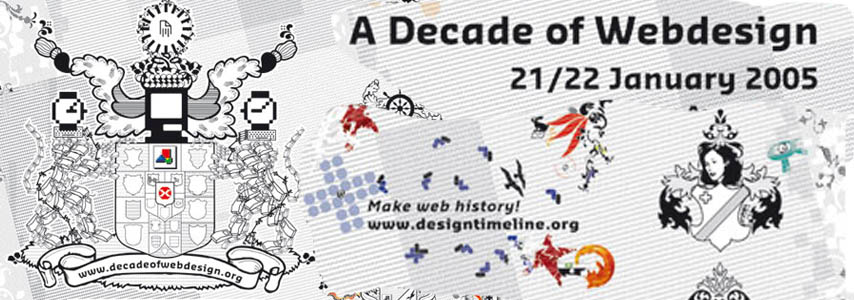A Decade of Webdesign

Two day international conference
Amsterdam, 21/22 January 2005
This site is a record of a conference marking the first ten years of web design that was held in Amsterdam in January 2005. The approach of the conference was to mix many means of understanding this first decade of work and creativity. The conference is archived here to act as a resource for further thinking about this field.
Here you will find: transcriptions and video footage of the presentations; a record of the blog produced live as a response to the speakers; information on the ideas and organisers behind the events and resources for contextualising what went on. All material is free for re-use in not-for profit contexts such as education.
Additionally, you will find a linked site, www.designtimeline.org. This is an archive of an online forum leading up to and following on from the conference, which provided a place for remembering, discussing and finding out about the first decade of webdesign. We hope you find this site useful and look forward to what we hope will be another ten years of invention and communication.
In 1994 the world wide web crept out of its scientific and academic egg and entered the first phases of popular consciousness. At this point the web design explosion began. Ten years later, we would like to stand back and attempt to map something of these years of frenetic and inventive interdisciplinary work.
What do we mean by web design? At the most obvious level, web design is about bringing visual organisation and power to computational and networked processes. It means organising sites by means of graphic elements and structuring devices. But increasingly digital media designers also work in the area of what used to be walled off as ‘technology’. Designing is now as much about formal language, that is to say, code, as much as it is about more subjective, free-form or ‘natural’ and visual languages. Designers make and link digital processes which are then taken up by social processes. They do this with a sensibility that is as much in dialogue with technicity as with a visual aesthetic or a model of communication.
Until recently web design discourses have been dominated by a frantic, market driven search for the latest and coolest. The ongoing media buzz around ‘demo design’ has prevented serious scholarship from happening.Technical innovations such as frames, Shockwave, Flash, WAP and 3G have dominated the field. Until 2001 a substantial part of the sector’s activities was geared towards instruction and consultancy. The dotcom crash and IT slump have cleared the field – but not necessary in positive ways. Due to budget cuts some firms now believe they can do without design altogether.
Instead of asking ourselves what the Next Big Thing will be, we firmly believe that future design can be found in the understanding of a recent past that offers a rich mix of utopian concepts and undigested controversies.
After the introduction of the personal computer in the eighties brought desk-top publishing, the introduction of networking in the nineties has proved a fundamental change in the field. Graphic design, only one area of the design we are talking about, as a practice has fundamentally changed, at once becoming empowered, but also strangely useless in its vocabulary and concepts.
Alongside this, we see the web as being a unique and massively distributed laboratory for vernacular and emergent designs. The Internet has been the biggest ever Rorschach test for media culture. Some of the key figures and sites over the last decade have developed outside of traditional computing or design sectors, or have been adapted from them by popular currents or idiosyncratic users in novel and inventive ways. Turning a media technology loose to work almost as a generative algorithm reiteratively developing through the hands and ideas of millions of users is an unprecedented experience in design.
In short, this ten years of web design has seen design change as much as it has seen the impact of a new form of global media. We want to celebrate this and to use a consideration and testing of the recent past to provide a platform for thinking about what is to come. In this, the conference will be unprecedented, the first event of its kind.


